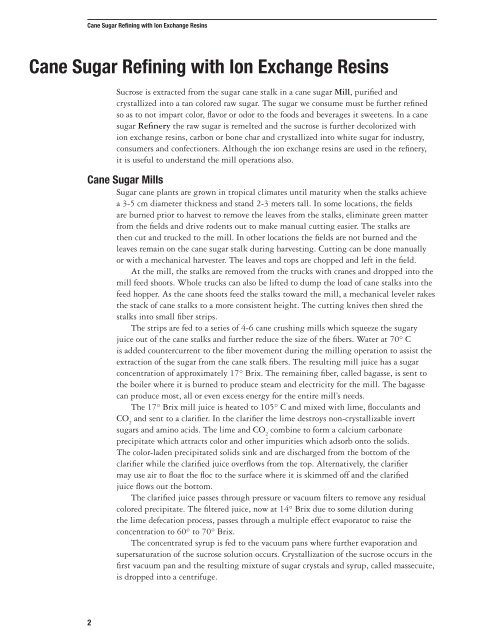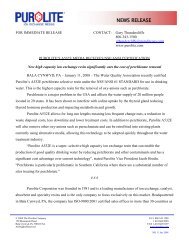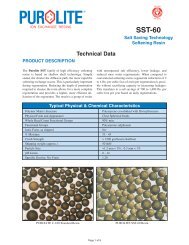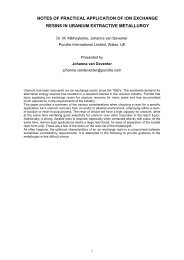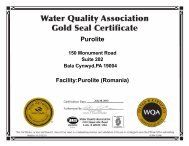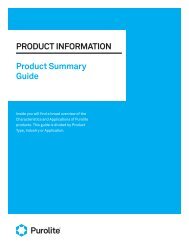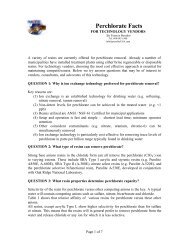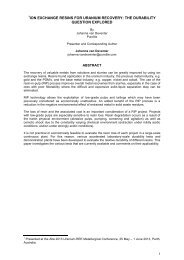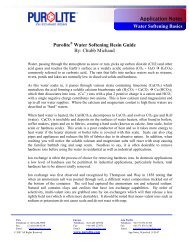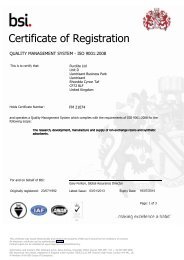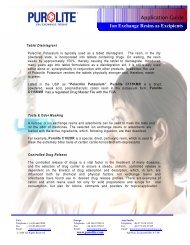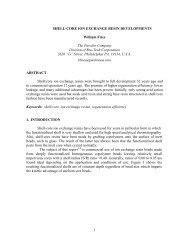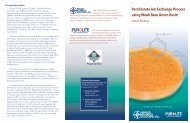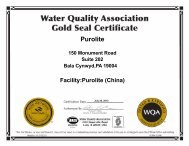Cane Sugar Refining - Purolite
Cane Sugar Refining - Purolite
Cane Sugar Refining - Purolite
You also want an ePaper? Increase the reach of your titles
YUMPU automatically turns print PDFs into web optimized ePapers that Google loves.
<strong>Cane</strong> <strong>Sugar</strong> <strong>Refining</strong> with Ion Exchange Resins<br />
<strong>Cane</strong> <strong>Sugar</strong> <strong>Refining</strong> with Ion Exchange Resins<br />
Sucrose is extracted from the sugar cane stalk in a cane sugar Mill, purified and<br />
crystallized into a tan colored raw sugar. The sugar we consume must be further refined<br />
so as to not impart color, flavor or odor to the foods and beverages it sweetens. In a cane<br />
sugar Refinery the raw sugar is remelted and the sucrose is further decolorized with<br />
ion exchange resins, carbon or bone char and crystallized into white sugar for industry,<br />
consumers and confectioners. Although the ion exchange resins are used in the refinery,<br />
it is useful to understand the mill operations also.<br />
<strong>Cane</strong> <strong>Sugar</strong> Mills<br />
<strong>Sugar</strong> cane plants are grown in tropical climates until maturity when the stalks achieve<br />
a 3-5 cm diameter thickness and stand 2-3 meters tall. In some locations, the fields<br />
are burned prior to harvest to remove the leaves from the stalks, eliminate green matter<br />
from the fields and drive rodents out to make manual cutting easier. The stalks are<br />
then cut and trucked to the mill. In other locations the fields are not burned and the<br />
leaves remain on the cane sugar stalk during harvesting. Cutting can be done manually<br />
or with a mechanical harvester. The leaves and tops are chopped and left in the field.<br />
At the mill, the stalks are removed from the trucks with cranes and dropped into the<br />
mill feed shoots. Whole trucks can also be lifted to dump the load of cane stalks into the<br />
feed hopper. As the cane shoots feed the stalks toward the mill, a mechanical leveler rakes<br />
the stack of cane stalks to a more consistent height. The cutting knives then shred the<br />
stalks into small fiber strips.<br />
The strips are fed to a series of 4-6 cane crushing mills which squeeze the sugary<br />
juice out of the cane stalks and further reduce the size of the fibers. Water at 70° C<br />
is added countercurrent to the fiber movement during the milling operation to assist the<br />
extraction of the sugar from the cane stalk fibers. The resulting mill juice has a sugar<br />
concentration of approximately 17° Brix. The remaining fiber, called bagasse, is sent to<br />
the boiler where it is burned to produce steam and electricity for the mill. The bagasse<br />
can produce most, all or even excess energy for the entire mill’s needs.<br />
The 17° Brix mill juice is heated to 105° C and mixed with lime, flocculants and<br />
CO 2 and sent to a clarifier. In the clarifier the lime destroys non-crystallizable invert<br />
sugars and amino acids. The lime and CO 2 combine to form a calcium carbonate<br />
precipitate which attracts color and other impurities which adsorb onto the solids.<br />
The color-laden precipitated solids sink and are discharged from the bottom of the<br />
clarifier while the clarified juice overflows from the top. Alternatively, the clarifier<br />
may use air to float the floc to the surface where it is skimmed off and the clarified<br />
juice flows out the bottom.<br />
The clarified juice passes through pressure or vacuum filters to remove any residual<br />
colored precipitate. The filtered juice, now at 14° Brix due to some dilution during<br />
the lime defecation process, passes through a multiple effect evaporator to raise the<br />
concentration to 60° to 70° Brix.<br />
The concentrated syrup is fed to the vacuum pans where further evaporation and<br />
supersaturation of the sucrose solution occurs. Crystallization of the sucrose occurs in the<br />
first vacuum pan and the resulting mixture of sugar crystals and syrup, called massecuite,<br />
is dropped into a centrifuge.<br />
2


